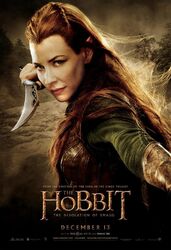"Tauriel" in The Hobbit: The Desolation of Smaug, 2013
image source
Will, Katie, and I saw the new Hobbit film last night. I've seen all three Lord of the Rings movies and the first Hobbit film, all directed by Peter Jackson. I can honestly say this is the first one I really liked on my own terms.
After reading this great post about the film, I understand why I like it so much more than Jackson's other film adaptations of Tolkien's story. I couldn't agree with blogger Natalie Wilson more when she says this:
"Not all Tolkien fans approve of this female addition to the story. But for me, Tauriel was the best part of a very good film—a film much better, in fact, than the first Hobbit film."
Wilson is right. Some Tolkien fundamentalists seem hesitant to embrace this change. While researching the character, I stumbled upon the excellent Lord of the Rings Wiki. You can check it out here. I laughed when I got to Tauriel's page and saw the big alert at the top:
"Non-Canon Alert!
This article contains information, pictures or media from non-canonical sources."
It all makes sense. Of course the character I love the most is non-canonical. I always liked Mary Magdalene in The Gospel of Mary from the Gnostic gospels the best too.
"Maria Magdalena" by Pietro Perugino, circa 1500
image source
Here's another great point Wilson makes in her post:
This second hobbit installment continues a trend from the first film, suggesting that gender’s not the problem, but that greed, domination, hunger for power and a taste for vengeance—characteristics often associated with being “real” men are. Tolkien’s work focuses on these destructive tendencies in many a male character, but he also gives us empathetic, heroic and kind-hearted males in Bilbo, Frodo, Sam and Gimli.
I was touched as I discussed the movie with Will when, after I told him I liked it so much more because of the strong, three-dimensional female character, Will said, "Well how do you think I like it when I see these dumbass action movies where all the dudes are dicks? It's like, hey, can we have a fun action film that features a nice guy for a change?"
It makes sense now why Will loves Tolkien's story so much. He can relate to the kind-hearted males.
Wilson continues her great analysis by pointing out Tolkien's message:
And if Smaug is not a symbol of patriarchal vileness at its worst, I don’t know what is. As Tolkien describes him, Smaug is “a most specially greedy, strong and wicked worm.” Smaug embodies death and destruction, with impenetrable armor and enough flame-power to destroy entire villages. Sounds kind of like the embodiment of a certain other empire—one intent on amassing wealth and power while dropping fire from the sky.
In contrast to Smaug—a phallic, Middle-Earth version of military drones—Tauriel represents hope in a war-torn world. She hungers for light, peace and love. Sure, she kills many orcs, but they, like Smaug, are intent on destruction. She does not kill for the sake of killing or hate because it is a tradition to do so.
In the past, I had begrudgingly gone to see all three Lord of the Rings films as well as the first Hobbit film with my husband because I'm the kind of person who loves to see people I love enjoy themselves. I watch cartoons that test my patience with Katie because I love to hear her laugh and see her face light up when something happens on the screen.
It's the same with Will. Action and adventure is so boring after ten minutes or so. I need dialogue. Words. Not just fancy moves and flashy colors. But I attend these fantasy action adventure movies with my husband because I love him and it makes him happy. Yes, I understand there's a story with actual words that I could follow, but too often, not having read the books myself because I like my books more like real life, funny and depressing, I have no idea what the characters are saying. I have a hard enough time understanding the real world, let alone some made up Middle Earth.
But after reading Wilson's analysis, I finally get it. I've finally seen the light.


No comments:
Post a Comment